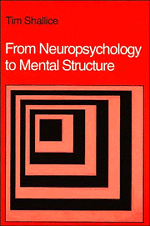Book contents
- Frontmatter
- Contents
- Preface
- I Introducing Cognitive Neuropsychology
- 1 From the Diagram-Makers to Cognitive Neuropsychology
- 2 The Cognitive Neuropsychology Approach
- II Converging Operations: Specific Syndromes and Evidence from Normal Subjects
- III Inferences from Neuropsychological Findings
- IV Central Processes: Equipotentiality or Modularity?
- References
- Subject Index
- Author Index
- Index of Patients Cited
2 - The Cognitive Neuropsychology Approach
from I - Introducing Cognitive Neuropsychology
Published online by Cambridge University Press: 21 October 2009
- Frontmatter
- Contents
- Preface
- I Introducing Cognitive Neuropsychology
- 1 From the Diagram-Makers to Cognitive Neuropsychology
- 2 The Cognitive Neuropsychology Approach
- II Converging Operations: Specific Syndromes and Evidence from Normal Subjects
- III Inferences from Neuropsychological Findings
- IV Central Processes: Equipotentiality or Modularity?
- References
- Subject Index
- Author Index
- Index of Patients Cited
Summary
On Modularity
If Lashley's (1929) idea of mass action were valid, then neuropsychology would be of little relevance for understanding normal function. Any form of neurological damage would deplete by a greater or lesser degree the available amount of some general resource, say the mythical g. Knowing which tasks a patient could or could not perform would enable us to partition tasks on a difficulty scale. It would tell us little, if anything, about how the system operated.
If one considers the design principles that might underlie cognitive systems, a rough contrast can be drawn between systems based on equipotentiality (e.g., those that follow principles such as mass action) and more modular ones. At a metatheo-retical level, some form of the ‘modularity’ thesis is probably the most widely accepted position in the philosophy of psychology today (e.g. Chomsky, 1980; Morton, 1981; Marr, 1982; Fodor, 1983). Over the past 30 years, the arguments for the position have become increasingly compelling and diverse; they are of a number of different types: computational, linguistic, physiological, and psychological.
The most basic argument is the computational one, which we owe to Simon (1969) and Marr (1976). In Marr's words.
Any large computation should be split up and implemented as a collection of small sub-parts that are as nearly independent of one another as the overall task allows. […]
- Type
- Chapter
- Information
- From Neuropsychology to Mental Structure , pp. 18 - 38Publisher: Cambridge University PressPrint publication year: 1988
- 2
- Cited by



